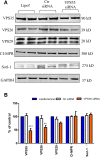Dysregulation of the Retromer Complex in Brain Endothelial Cells Results in Accumulation of Phosphorylated Tau
- PMID: 35002279
- PMCID: PMC8721160
- DOI: 10.2147/JIR.S342096
Dysregulation of the Retromer Complex in Brain Endothelial Cells Results in Accumulation of Phosphorylated Tau
Abstract
Introduction: Transport through endothelial cells of the blood-brain barrier (BBB) involves a complex group of structures of the endo-lysosome system such as early and late endosomes, and the retromer complex system. Studies show that neuronal dysregulation of the vacuolar protein sorting 35 (VPS35), the main component of the retromer complex recognition core, results in altered protein trafficking and degradation and is involved in neurodegeneration. Since the functional role of VPS35 in endothelial cells has not been fully investigated, in the present study we aimed at characterizing the effect of its downregulation on these pathways.
Methods: Genetic silencing of VPS35 in human brain endothelial cells; measurement of retromer complex system proteins, autophagy and ubiquitin-proteasome systems.
Results: VPS35-downregulated endothelial cells had increased expression of LC3B2/1 and more ubiquitinated products, markers of autophagy flux and impaired proteasome activity, respectively. Additionally, compared with controls VPS35 downregulation resulted in significant accumulation of tau protein and its phosphorylated isoforms.
Discussion: Our findings demonstrate that in brain endothelial cells retromer complex dysfunction by influencing endosome-lysosome degradation pathways results in altered proteostasis. Restoration of the retromer complex system function should be considered a novel therapeutic approach to rescue endothelial protein transport.
Keywords: Alzheimer’s disease; autophagy; brain endothelial cells; endosomal trafficking; retromer complex; tau protein; ubiquitin-proteasome.
© 2021 Filippone et al.
Conflict of interest statement
All authors declare no conflicts of interest.
Figures





Similar articles
-
VPS35 Downregulation Alters Degradation Pathways in Neuronal Cells.J Alzheimers Dis. 2021;84(3):1079-1089. doi: 10.3233/JAD-210701. J Alzheimers Dis. 2021. PMID: 34602481 Free PMC article.
-
Formation of retromer transport carriers is disrupted by the Parkinson disease-linked Vps35 D620N variant.Traffic. 2021 Apr;22(4):123-136. doi: 10.1111/tra.12779. Epub 2021 Jan 22. Traffic. 2021. PMID: 33347683
-
Parkin mediates the ubiquitination of VPS35 and modulates retromer-dependent endosomal sorting.Hum Mol Genet. 2018 Sep 15;27(18):3189-3205. doi: 10.1093/hmg/ddy224. Hum Mol Genet. 2018. PMID: 29893854 Free PMC article.
-
Understanding the contributions of VPS35 and the retromer in neurodegenerative disease.Neurobiol Dis. 2022 Aug;170:105768. doi: 10.1016/j.nbd.2022.105768. Epub 2022 May 16. Neurobiol Dis. 2022. PMID: 35588987 Free PMC article. Review.
-
VPS35-Retromer: Multifunctional Roles in Various Biological Processes - A Focus on Neurodegenerative Diseases and Cancer.J Inflamm Res. 2025 Apr 3;18:4665-4680. doi: 10.2147/JIR.S510768. eCollection 2025. J Inflamm Res. 2025. PMID: 40195959 Free PMC article. Review.
Cited by
-
Sodium Propionate Contributes to Tumor Cell Growth Inhibition through PPAR-γ Signaling.Cancers (Basel). 2022 Dec 29;15(1):217. doi: 10.3390/cancers15010217. Cancers (Basel). 2022. PMID: 36612214 Free PMC article.
-
The interaction between dysfunction of vasculature and tauopathy in Alzheimer's disease and related dementias.Alzheimers Dement. 2025 Feb;21(2):e14618. doi: 10.1002/alz.14618. Alzheimers Dement. 2025. PMID: 39998958 Free PMC article. Review.
-
TDP-43-stratified single-cell proteomics of postmortem human spinal motor neurons reveals protein dynamics in amyotrophic lateral sclerosis.Cell Rep. 2024 Jan 23;43(1):113636. doi: 10.1016/j.celrep.2023.113636. Epub 2024 Jan 5. Cell Rep. 2024. PMID: 38183652 Free PMC article.
-
Rebalance of mitophagy by inhibiting LRRK2 improves colon alterations in an MPTP in vivo model.iScience. 2024 Sep 16;27(10):110980. doi: 10.1016/j.isci.2024.110980. eCollection 2024 Oct 18. iScience. 2024. PMID: 39635134 Free PMC article.
-
EhVps35, a retromer component, is a key factor in secretion, motility, and tissue invasion by Entamoeba histolytica.Front Cell Infect Microbiol. 2024 Sep 27;14:1467440. doi: 10.3389/fcimb.2024.1467440. eCollection 2024. Front Cell Infect Microbiol. 2024. PMID: 39397861 Free PMC article.
References
Grants and funding
LinkOut - more resources
Full Text Sources
Miscellaneous

